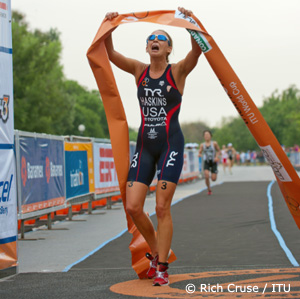Sarah Haskins targets London
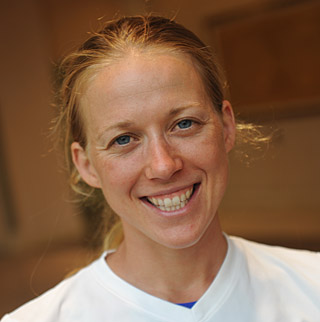
Sarah Haskins took a little while to celebrate her first ITU World Cup win at Monterrey, Mexico. But the 30-year-old from St. Louis was soon back at work preparing for her August 6 rendezvous with the first USA Olympic Trials test at the London World Championship Series event. If she is the first American woman and places in the top 9 of this Olympic preview contest, she will earn a spot on her second Olympic team.
Given her star studded record which includes a silver medal at the 2008 ITU World Championship and a 4th at the 2009 ITU World Championships Series Grand Final, an 11th at the Beijing Olympics, multiple wins at the Life Time Fitness / Toyota Cup series races in Minneapolis and Chicago, and three wins at St. Anthony’s, it’s amazing to note that she has done all this while coping with a peroneal nerve entrapment that has deactivated some of the crucial muscles in her left leg.
Slowtwitch: Congratulations on winning the Monterrey World Cup – your first. It’s been amazing what you have done while fighting the long term consequences of a serious leg injury the last four years.
Sarah Haskins: It’s definitely been frustrating. I had a pretty serious injury in the Lisbon World Cup in 2007. My foot went into the crack in the road on the third lap of the run and it led to a really serious, long-term injury. At the time I could suck it up and run. But from that point on the leg never felt quite right. It created a nerve injury. I didn’t know that was the injury until February 2009 when I had surgery to fix the peroneal nerve entrapment.
ST: What was the scope of that injury and operation?
Sarah: Actually believe it or not it was up by my knee even though it started with an ankle injury. The knee was the incision point for the surgery for peroneal knee entrapment. Dr. Robert Bray did the surgery in Marina del Rey. He did a very good job. The nerve injury typically takes two years to fully come back. It’s been a bit of a process since then. Definitely felt much better after the surgery.
ST: You had some great results after your injury – 4th at 2007 Hy-Vee, 2nd at the 2008 ITU Word Championship, 11th at the Beijing Olympics – and after your operation – wins at 2009 Life Time Fitness Minneapolis and Chicago, 4th at the 2009 Washington DC World Championship Series race, 4th at the 2009 ITU World Championship Series Grand Final. When did you really know something was wrong long term?
Sarah: It was actually in ‘09 when I knew something was wrong. After the World Championship silver medal in ‘08, I thought ‘Wow my calf is really sore. It takes a while for the body’s compensation for the nerve damage while running to really start to make my calf and foot hurt. I would eventually get to the point where my body could not do this any more and I would have to take time off.
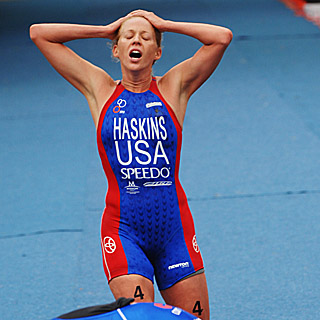
ST: While you were coping remarkably well, things in your ankle to your knee were not working properly. Can you describe the long term toll it was taking?
Sarah: For my specific nerve injury, there were several muscles deactivated for me in my foot, ankle and related parts of my body. Essentially I was able to run with several key muscles deactivated by the injury and other muscles were heavily compensating for them. Basically, due to the compensation, I had calf tears, calf tightness and extensive muscle soreness that took much longer to recover from after a race or a tough workout.
ST: So how have you gone about treating this condition while racing so well? If I remember correctly, the surgeon said it would take two years for the muscles and nerves affected by the peroneal entrapment to start working at full capacity again?
Sarah: For the past few years I had to have my body learn to unwind from compensations of nerve injuries. But last year, I started racing so much, my plate was so full, things came to a head again. I finished 8th at Sydney WCS, won St. Anthony’s, took 9th at Seoul and three weeks later went to Madrid WCS and finished 5th. Which was one of my best finishes of the year. Unfortunately at that race I made a poor choice as an athlete. I felt my run was really good and I chose to wear new shoes which were way wrong for me – super light, like track spikes. My left foot not ready for that and I got injured, I got a huge blister on the bottom of my foot and I started to run on the outside of my foot. At that point, I raced on an injured foot at Hy-Vee and did not have a good race and I finished 16th — completely exhausted.
ST: It is amazing that that did not end your year. But wasn’t it a warning shot across the bow from your body to your brain?
Sarah: After some rest, I raced pretty well. I won the Life Time Fitness in Minneapolis and Chicago and then a bit after that I suffered a calf tear. When you try to run through pain with a real injury, it is not smartest thing to do the same thing over a whole season, exacerbating the over compensation issues. It cut my season short.
ST: Is the calf tear fully healed?
Sarah: Last fall I started to run again in November. Since then I have been doing my work with the bosu ball and MAT techniques and it’s been much better. I have had huge success with this form of treatment and will continue this keep fingers crossed.
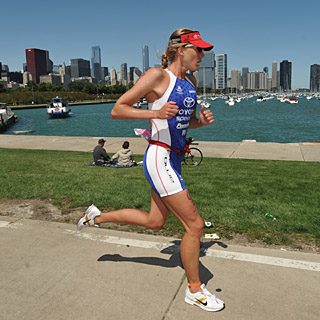
ST: What has been the core of your recovery?
Sarah: I did extensive work with physical therapist Bob Holtby and Dr. Bill Moreau in Colorado Springs and with Suzanne Gross in Orlando while training in Clermont. One of the key therapies is called MAT – Muscle Activation Therapy — which was recommended to me by Jarrod Shoemaker. In essence, MAT works to renew muscles deactivated by the injury – in my case the glute, spine and hip and lower left leg. As these muscles came back, they help decrease the pain that and left my foot free to function more properly and decrease the stress on muscles that caused foot to work harder and led to the calf tears.
ST: Where does your recovery stand now?
Sarah: I have normal soreness, but not to point when I was injured. It was a huge relief — you could say it is great to be able to push my body physically as much as I want to push it and not be hampered. Now I can have longer workouts and recover normally and I have noticed huge improvements. I will continue this and keep my fingers crossed.
ST: It seems like a loaded race schedule and travel all around the world probably hindered your long term recovery. What are you doing differently?
Sarah: This year I am taking a different approach. Last year I raced on 4 continents in 3 months and that was too much for my body to handle. Part of the stress comes when you are injured, you depend on how well the body can recover. This year Nate [Kortuem, her husband and coach] and I decided not to travel as much internationally. It is really taxing with all World Championship Series [WCS] races not in North America. Personally my body would require I move to Europe to race the entire WCS series. I really like to race the 5150 and LTF-Toyota series in the USA. But my main focus this year is to race London and qualify for the Olympics. That’s a one-time shot, a focus on what can I do to best perform one day. For me that means not to travel around the world 16 months before the Olympics. I need to get ready now to be the top American at the London WCS race. So for now, I will continue to get in shape with North American races and a few WCS races in Europe.
ST: You did so well, from the outside it didn’t look like you weren’t at full speed. Did the lack of understanding of your plight add to your stress?
Sarah: When you have an injury, it is very frustrating. Not only physically but it’s even more mentally challenging. I think it is one of most difficult things an athlete goes through. You want to race but the body doesn’t let you. For me just being able to run and race pain-free is a great feeling. A most important thing. To race well I must enjoy what I am doing and be able to recover for the next race. On top of that I want to be able to perform to the best of my ability. It is really frustrating to not be able to perform your best. As an athlete you are always trying to get that extra one percent better. With nutrition, recovery, you try to get best of effort out of muscles you can. You need your body to work properly
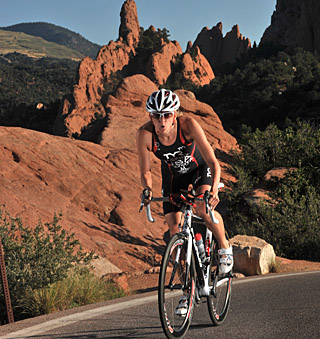
ST: So this seems to dictate a drive for perfection on all fronts.
Sarah: You definitely get frustrated and worried.. I continue to seek venues to get better and try techniques. When I knew something is wrong I cannot give up on myself. I have to keep trying. The past year I raced and did well. I had five wins, so I can’t complain about that. But the inconsistency wears on me and is stressful — worrying all the time if things were going to break. I did a good job at compensation and taking care. But you never know what can happen. You could have a bike crash tomorrow. With so many obstacles and so many things to overcome – it’s all part of being a triathlete. You need to competitive and move forward and not be afraid to try new things every day, after every win, after every race. Even though I’ve been in the sport seven years, I still have a lot to learn. I have to keep my mind open for new things.
ST: still it was a landmark to win your first ITU World Cup at Monterrey? Howe did it go?
Sarah: The swim was very interesting. I actually went in with the idea that if things got congested the first 100m not to worry about it, relax the rest of the swim and work my way up on the remainder of the 1500 meter swim. So at the start of the swim things got bunched up and I stopped at 50 meters and moved to right side and swam hard up to the leaders. I stayed in a group of six girls and when we finished we had 40 seconds on the field. Soon after the start of the bike, I noted Flora Duffy and I were gapping the other girls a good amount, so the first lap I told Flora ‘Let’s go! ‘ The two of us rode 5 laps and had great fun.
ST: Shades of your breakaway with Helen Jenkins at the 2008 ITU World Championship in Vancouver.
Sarah: About the 5th lap, I looked behind and saw Flora was gapped a bit and I wondered what happened to her. Then I had to decide whether to wait for Flora or go. There were only two and a half laps left, so I thought . I’m gonna do this. I’m gonna go! I had a 1 minute lead at T2, so I thought ‘Stay in control.’ Coming into transition by myself was so much easier. I was not stressed out, I got my feet in my shoes in a transition that was much better than in a big group. So I started off the run thinking to stay relaxed. I knew I needed a strong run but I had no idea what pace I was running. When I saw a huge pack at the turn around on the last lap, I got very nervous. I had some coaches give me splits and with a mile left I started to get nervous about [Ai] Ueda. She was really moving the last 800 meters and I expected her to pass me. All the time on breakaways, I get passed right at the end. But I told myself there is no way I am going to lead 9.9 of a 10k run! I just focused on pace and I didn’t look around. At the end I didn’t know where she was. I just kept charging and just got to the tape first. I was so overwhelmed I was shocked. I kept thinking she was going to pass me and I tried to go to the next gear. I just was so happy I was able to pull it off.

ST: How might this have gone in a WCS race?
Sarah: World Cup ITU races are different. You can be all by yourself on the bike and run and can execute the plan and walk away with the win. That being said, at a WCS race it is virtually impossible. If Nicola Spirig and Lisa Norden are behind you, it’s virtually impossible to execute a solo bike breakaway. I was still very excited to walk away with the win. But I know WCS races offer a whole other level of challenge.
ST: It sounds like you have been haunted by getting passed at the line. How far does this go back?
Sarah: I look back on my career and remember in 2006 at the Madrid World Cup I had a breakaway with Andrea Hewitt. On the last 2k of the run I got passed by about 10 girls. That was before I knew how to hydrate well on the bike. I learned so much. After that, usually in sprint finishes at the end of the run, I often ended up second. At the 2007 World Cup in Vancouver I made a break with Sara McLarty and the last mile Sam Warriner went by and I got beaten by a few seconds. I was just never able to hold on to break the tape at an ITU race.
ST: How strong are the American women going into the 2012 Olympics?
Sarah: They look very strong. Of my fellow American women, Laura [Bennett] has amazing experience and knows how to do the big races. She is definitely very strong. Gwen Jorgensen is a good up and coming competitor and is a fantastic runner. Every race she will gain so much experience on the bike. Jillian Peterson was disappointed in Mexico, but she is improving fast. She is a fellow home town St. Louis girl. I helped get her get into the sport. And Sarah Groff started in the sport the same time as me. She is always right there, very strong. I think there are a great group of American women who are strong, exciting and will be right there.


